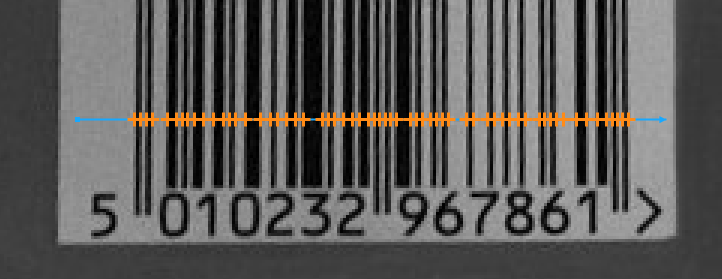You are here: Start » FIL.NET » FIL.ScanExactlyNEdges
Locates a specified number of the strongest transitions between dark and bright pixels along a given path.
| Namespace: | FilNet |
|---|---|
| Assembly: | FIL.NET.dll |
Syntax
public static void ScanExactlyNEdges ( FilNet.Image inImage, FilNet.ScanMap inScanMap, FilNet.EdgeScanParams inEdgeScanParams, int inEdgeCount, FilNet.Selection inEdgeSelection, float inMinDistance, float? inMaxDistance, FilNet.LocalBlindness? inLocalBlindness, INullable<List<FilNet.Edge1D>> outEdges, INullable<List<FilNet.Gap1D>> outGaps )
Parameters
| Name | Type | Range | Default | Description | |
|---|---|---|---|---|---|
 | inImage | FilNet.Image | Input image. | ||
 | inScanMap | FilNet.ScanMap | Data precomputed with CreateScanMap. | ||
 | inEdgeScanParams | FilNet.EdgeScanParams | Parameters controlling the edge extraction process. | ||
 | inEdgeCount | int | <0, INF> | 1 | Number of edges to be found. Default value: 1. |
 | inEdgeSelection | FilNet.Selection | fil::Selection::Best | Selection mode of the resulting edges. Default value: fil::Selection::Best. | |
 | inMinDistance | float | <0.0f, INF> | 0.0f | Minimal distance between consecutive edges. Default value: 0.0f. |
 | inMaxDistance | float? | <0.0f, INF> | Maximal distance between consecutive edges. Default value: ftl::NIL. | |
 | inLocalBlindness | FilNet.LocalBlindness? | Defines conditions in which weaker edges can be detected in the vicinity of stronger edges. Default value: ftl::NIL. | ||
 | outEdges | FilNet.INullable<System.Collections.Generic.List<FilNet.Edge1D>> | Found edges. This parameter cannot be null. | ||
 | outGaps | FilNet.INullable<System.Collections.Generic.List<FilNet.Gap1D>> | Gaps between consecutive edges. This parameter cannot be null. |
Description
The operation scans the image using inScanMap previously generated from a scan path and finds a set of inEdgeCount image edges perpendicular to the path. If no subset (of inEdgeCount elements) of detected edges meets the requirements of inEdgeScanParams.minMagnitude, inMinDistance, inEdgeScanParams.edgeTransition then the outputs are set to NIL.
Note that in case of a scan path which is closed, the parameters controlling the distances between consecutive found objects do not control the distance between the first and the last of the found objects (counting from the beginning of the scan path).
Examples

ScanExactlyNEdges locates the edges using a scan map representing the scan path above (inEdgeCount = 61).
Remarks
Read more about Local Coordinate Systems in Machine Vision Guide: Local Coordinate Systems.
This filter is a part of the 1D Edge Detection toolset. For a comprehensive introduction to this technique please refer to 1D Edge Detection and 1D Edge Detection - Subpixel Precision chapters of our Machine Vision Guide.
Function Overrides
- ScanExactlyNEdges(Image, ScanMap, EdgeScanParams, Int32, Selection, Single, INullable<List<Edge1D>>, INullable<List<Gap1D>>)
- ScanExactlyNEdges(Image, ScanMap, EdgeScanParams, Int32, Selection, Single, INullable<List<Edge1D>>, INullable<List<Gap1D>>, Profile, Profile)
- ScanExactlyNEdges(Image, ScanMap, EdgeScanParams, Int32, Selection, Single, Nullable<Single>, Nullable<LocalBlindness>, INullable<List<Edge1D>>, INullable<List<Gap1D>>, Profile, Profile)

